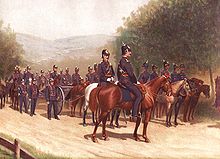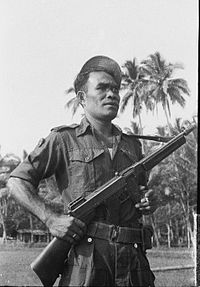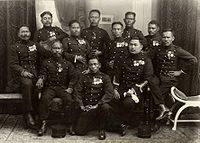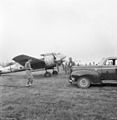- Royal Netherlands East Indies Army
-
This article is part of the
History of Indonesia series
See also:
Timeline of Indonesian History Prehistory Early kingdoms Kutai (4th century) Tarumanagara (358–669) Kalingga (6th–7th century) Srivijaya (7th–13th centuries) Sailendra (8th–9th centuries) Sunda Kingdom (669–1579) Medang Kingdom (752–1045) Kediri (1045–1221) Singhasari (1222–1292) Majapahit (1293–1500) The rise of Muslim states Spread of Islam (1200–1600) Sultanate of Ternate (1257–present) Malacca Sultanate (1400–1511) Sultanate of Demak (1475–1548) Aceh Sultanate (1496–1903) Sultanate of Banten (1526–1813) Mataram Sultanate (1500s–1700s) European colonization The Portuguese (1512–1850) Dutch East India Co. (1602–1800) Dutch East Indies (1800–1942) The emergence of Indonesia National awakening (1908–1942) Japanese occupation (1942–45) National revolution (1945–50) Independent Indonesia Liberal democracy (1950–57) Guided Democracy (1957–65) Start of the New Order (1965–66) The New Order (1966–98) Reformasi era (1998–present) The Royal Netherlands East Indies Army (Koninklijk Nederlands Indisch Leger; KNIL) was the military force maintained by the Netherlands in its colony of the Netherlands East Indies (also known as the Dutch East Indies, and now modern Indonesia). The KNIL's air arm was the Royal Netherlands East Indies Army Air Force. Elements of the Royal Netherlands Navy were also stationed in the Netherlands East Indies.
Contents
History 1830–1942
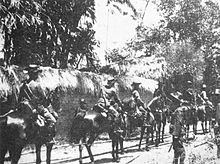 Cavalry of the Royal Dutch East India Army in 1906 during the Dutch intervention in Bali (1906).
Cavalry of the Royal Dutch East India Army in 1906 during the Dutch intervention in Bali (1906).
The KNIL was formed by royal decree on 10 March 1830. It was not part of the Royal Netherlands Army, but a separate military arm specifically formed for service in the Netherlands East Indies. Its establishment coincided with the Dutch drive to expand colonial rule from the 17th century area of control to the far larger territories comprising the Dutch East Indies seventy years later, which remain the present boundaries of Indonesia.[1][not in citation given]
In 1894, Lombok and Karangasem were annexed in response to reports of the local Balinese aristocracy oppressing the native Sasak people.[2] Bali was finally taken under full control with the Dutch intervention in Bali (1906) and the final Dutch intervention in Bali (1908).[2] The KNIL was involved in many campaigns against indigenous groups in the Netherlands East Indies including the Padri War (1821–1845), the Java War (1825–1830), crushing the final resistance of Bali inhabitants to colonial rule in 1849, and the prolonged Aceh War (1873–1904).[3]
After 1904 the Netherlands East Indies were considered "pacified", with no large-scale armed opposition to Dutch rule until World War II, and the KNIL served a mainly defensive role protecting the Dutch East Indies from the possibility of foreign invasion. In the nineteenth and early twentieth centuries, the KNIL prosecuted the conquest of the Indonesian archipelago. Once the archipelago was considered "pacified" the KNIL was mainly involved with military police tasks. To ensure a sizeable European military segment in the KNIL and reduce costly recruitment in Europe the colonial government introduced obligatory military service for all male conscripts in the European legal class in 1917.[4] In 1922 a supplemental legal enactment introduced the creation of a ‘Home guard’ (Dutch: Landstorm) for European conscripts older than 32.[5]
No large-scale armed opposition to Dutch rule existed until World War II. The KNIL hastily and inadequatly attempted to transform into modern military force able to protect the Dutch East Indies from foreign invasion. On the eve of the Japanese invasion in December 1941, Dutch regular troops in the East Indies comprised about 1,000 officers and 34,000 men, of whom 28,000 were indigenous. After the defeat and occupation of the Netherlands by Nazi Germany, in 1940 the KNIL was cut off from the Dutch Army, except for the Royal Navy stationed in the colony. During the Dutch East Indies campaign of 1941–42 the KNIL and the Allied forces were quickly defeated.[6] All European soldiers, which in practice included all able bodied Indo-European males, were interned by the Japanese as POWs. 25% of the POWs did not survive their internment.
World War II
The KNIL was the main defense against the Japanese invading the Netherlands East Indies during World War II. Dutch forces had been severely weakened by the defeat and occupation of the Netherlands itself, by Nazi Germany, in 1940. Nevertheless, at the start of the Pacific War, in December 1941, Dutch forces in Indonesia numbered around 85,000 troops, a combination of European and indigenous regular soldiers, locally organised militia, territorial guard units and civilian volunteers. The KNIL air force, Militaire Luchtvaart KNIL (Royal Netherlands East Indies Air Force (ML-KNIL))[7] numbered 389 planes of all types, but was largely outclassed by superior Japanese planes. The Royal Netherlands Navy Air Service, or MLD, also had significant forces in the NEI.[8] The Dutch East Indies campaign of 1941–42 saw the Dutch and associated allied (especially ABDA) forces quickly defeated.[9]
1945–1950
Following World War II, the reconstituted KNIL was used in two large military campaigns in 1947 and 1948 to re-establish Dutch control of Indonesia. In the course of this "police action" accusations of war crimes were levelled against the KNIL and its Ambonese auxiliaries. Dutch efforts to re-establish their colony failed and Netherlands recognition of Indonesian sovereignty came on 27 December 1949.[10] On 26 January 1950, elements of the KNIL were involved in an abortive coup in Bandung planned by Raymond Westerling and Sultan Hamid II. The coup failed and only accelerated the dissolution of the federal Republic of the United States of Indonesia.[11]
The KNIL was disbanded by 26 July 1950 with its indigenous personnel being given the option of demobilizing or joining the Indonesian military.[12] However, efforts to integrate former KNIL units were impeded by mutual distrust between the predominantly Ambonese KNIL troops and the Javanese-dominated Republican military; leading to clashes at Makassar in April and the attempted secession of an independent Republic of South Maluku (RMS) in July.[11] These revolts were suppressed by November 1950 and approximately 12,500 Ambonese KNIL personnel and their families opted for temporary resettlement in the Netherlands.[13] Following this, the KNIL ceased to exist but its traditions are maintained by the Regiment Van Heutsz of the modern Royal Netherlands Army. At the time of disbandment the KNIL numbered 65,000, of whom 26,000 were incorporated into the new Indonesian Army. The remainder were either demobilised or transferred to the Netherlands Army.[14]
Recruiting
During the 19th century the KNIL recruited Dutch volunteers, European mercenaries of other nationalities (especially Germans, Belgians and Swiss).[15]. During the protracted Aceh War the numbers of European troops were kept to 12,000 but continued Achenese resistance necessitated the deployment of up to 23,000 indigenous soldiers (mainly from Java, Ambon, and Manado).[16] Even members of the Ashanti (an African tribe from the present Ghana) were recruited in limited numbers for service in the East Indies (see Belanda Hitam).[17] The ratio of foreign and indigenous troops to those of Dutch origin was reported to be 60% to 40%. After the Aceh War, the enlistment of non-Dutch European troops ceased and the KNIL came to consist of Dutch regulars recruited in the Netherlands itself, Indonesians, Indos (Eurasians), and Dutch colonists living in the East Indies and undertaking their military service.
It was against the law to send Dutch conscripts from the Netherlands to the Netherlands East Indies but Dutch volunteers continued to enlist for colonial service. In 1890 a Colonial Reserve (Koloniale Reserve) was established in the Netherlands itself to recruit and train these volunteers and to re-integrate them into Dutch society upon the conclusion of their overseas service. On the eve of the Japanese invasion in December 1941, Dutch regular troops in the East Indies comprised about 1,000 officers and 34,000 men, of whom 28,000 were indigenous. The largest contingent of these indigenous troops had always consisted of Javanese and Sundanese soldiers.[18][19] During the Japanese occupation, most of the Dutch and Ambonese personnel were interned in POW camps.
During the Indonesian National Revolution, the KNIL's officers were still largely Dutch and Eurasians although most of its troops were recruited from predominantly Christian eastern Indonesia, particularly the South Moluccas, Timor and Manado. Although there were smaller numbers of Javanese, Sundanese, Sumatran and other Muslim troops in Dutch service, these received comparatively lower rates of pay than their Christian counterparts, leading to resentment and distrust. The Dutch sought to take advantage of these ethnic tensions by claiming that the Ambonese would lose their special privileges and pensions under a Javanese-dominated government.[11] As noted above, these factors contributed to clashes between demobilized KNIL units and the Republic of Indonesia's military throughout 1950.[11]
-
Mitsubishi Ki-46 aircraft captured by KNIL forces at Menado, Celebes, 3 October 1945
-
The Vickers light amphibious tank was used by Dutch forces in the East Indies.
Notes
- ^ The Royal Netherlands Indies Army
- ^ a b Vickers, Adrian. (2005) A History of Modern Indonesia. Cambridge: Cambridge University Press. p10–11
- ^ Ibrahim, Alfian. "Aceh and the Perang Sabil." Indonesian Heritage: Early Modern History. Vol. 3, ed. Anthony Reid, Sian Jay and T. Durairajoo. Singapore: Editions Didier Millet, 2001. p132–133
- ^ Willems, Wim ‘Sporen van een Indisch verleden (1600-1942).’ (COMT, Leiden, 1994). Chapter I, P.32-33 ISBN 90 71042 44 8
- ^ Willems, Wim ‘Sporen van een Indisch verleden (1600-1942).’ (COMT, Leiden, 1994). Chapter I, P.32-36 ISBN 90 71042 44 8
- ^ Klemen, L (1999-2000). "Dutch East Indies 1941-1942". Dutch East Indies Campaign website. http://www.dutcheastindies.webs.com/index.html.
- ^ Broshot, James (1999-2000). "Dutch Air Force Order of Battle in the Dutch East Indies, 30 November 1941". Dutch East Indies Campaign website. http://www.dutcheastindies.webs.com/Dutch_OOB.html.
- ^ "Armed Forces of World War II" Andrew Mollo ISBN 0-85613-296-9
- ^ Klemen, L (1999-2000). "Dutch East Indies 1941-1942". Dutch East Indies Campaign website. http://www.dutcheastindies.webs.com/index.html.
- ^ "Last Post – the End of Empire in the Far East", John Keay ISBN 0-7195-5589-2
- ^ a b c d Kahin, George McT. Nationalism and Revolution in Indonesia. Ithaca, New York: Cornell University Press, 1952. p452
- ^ http://cgi.omroep.nl/cgi-bin/streams?/tv/vpro/GE/sb.Plechtighedendjakartapolygoon.asf?title=De plechtigheden in Djakarta bij de opheffing van het KNIL Polygoon 1950 3 min. 20;embed=1 Video footage showing the official ceremony disbanding the KNIL
- ^ The complicated story of the disbanding of the KNIL is set out briefly here. For a more extended analysis see Manuhutu (1987); Steylen (1996: 33–63); van Amersfoort (1982: 101–8). The psychological impact of the dissolution of the KNIL on the Ambonese servicemen is described in Wittermans (1991).
- ^ John Keegan, page 314 "World Armies", ISBN0-333-17236-1
- ^ Blakely, Allison (2001). Blacks in the Dutch World: The Evolution of Racial Imagery in a Modern Society. Indiana University Press. p. 15 ISBN 0-253-31191-8
- ^ Vickers (2005), p. 13
- ^ Radio Netherlands Worldwide – Ghana's Java connection
- ^ Javanese have always been the largest indigenous element of the colonial army. Cribb, R.B. (2004) ‘Historical dictionary of Indonesia.’ Scarecrow Press, Lanham, USA.ISBN 0 8108 4935 6, p. 221 [1]
- ^ The KNIL statistics of 1939 show at least 13,500 Javanese and Sundanese under arms compared to 4,000 Ambonese soldiers.Source: Netherlands Ministry of Defense.
References
- Bosma, Ulbe: Emigration: Colonial circuits between Europe and Asia in the 19th and early 20th century, European History Online, Mainz: Institute of European History, 2011, retrieved: May 23, 2011.
- Hoofdkwartier Militaire Luchtvaart – Overzicht 1947 (5 pc), 'Flash Aviation', 2005.
External links
- Global Security – Royal Dutch Indian Army
- Netherlands Institute for War Documentation: East Indies Camp Archives
- Womack, Tom. "An Abandoned Army: The KNIL and The Japanese Invasion of Northern Dutch Sumatra". The Netherlands East Indies 1941–1942. http://www.dutcheastindies.webs.com/north_sumatra.html.
Categories:- Military units and formations established in 1830
- Military history of Indonesia
- Disbanded armies
- Royal Netherlands Army
- Dutch East Indies
-
Wikimedia Foundation. 2010.

